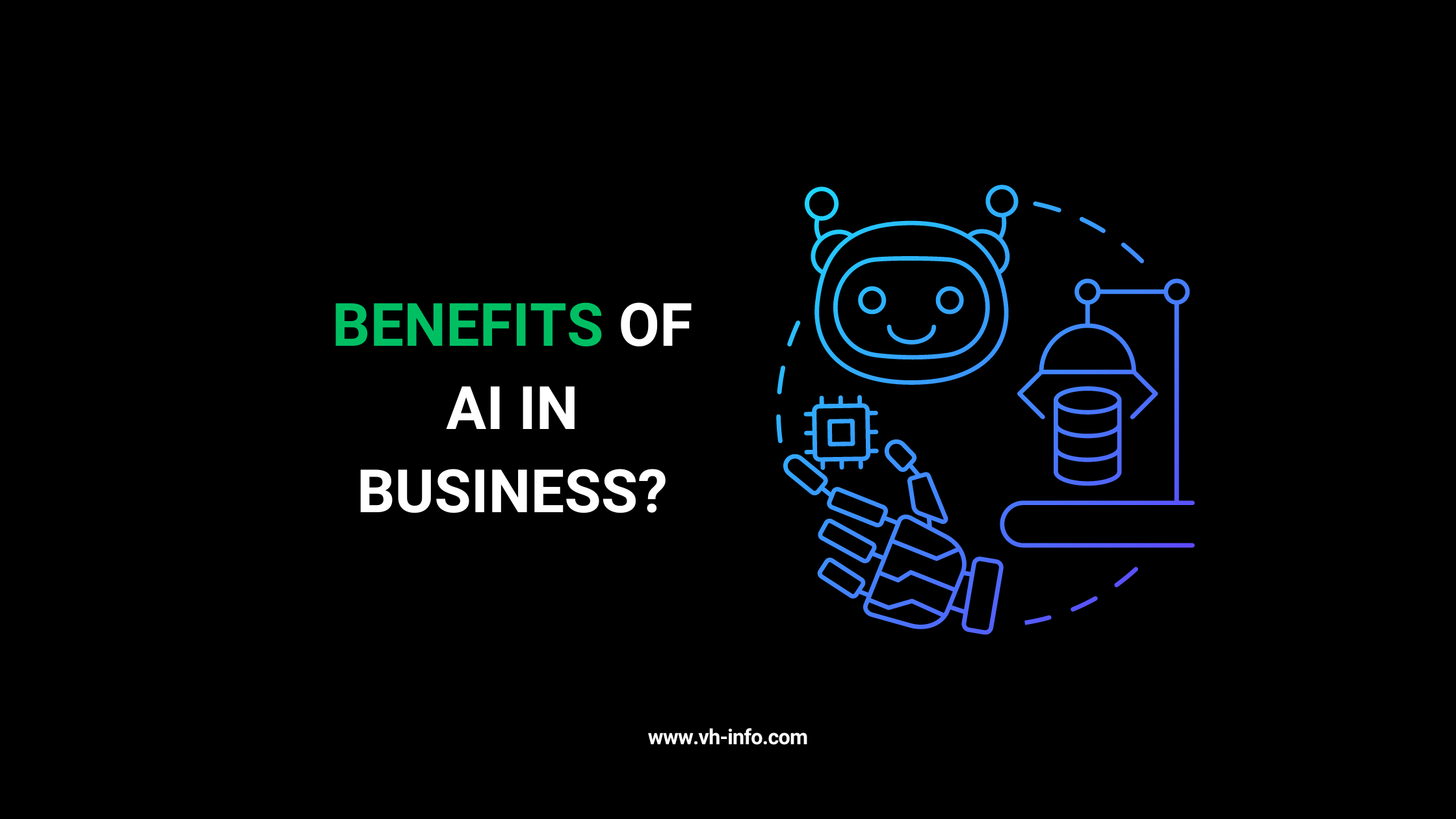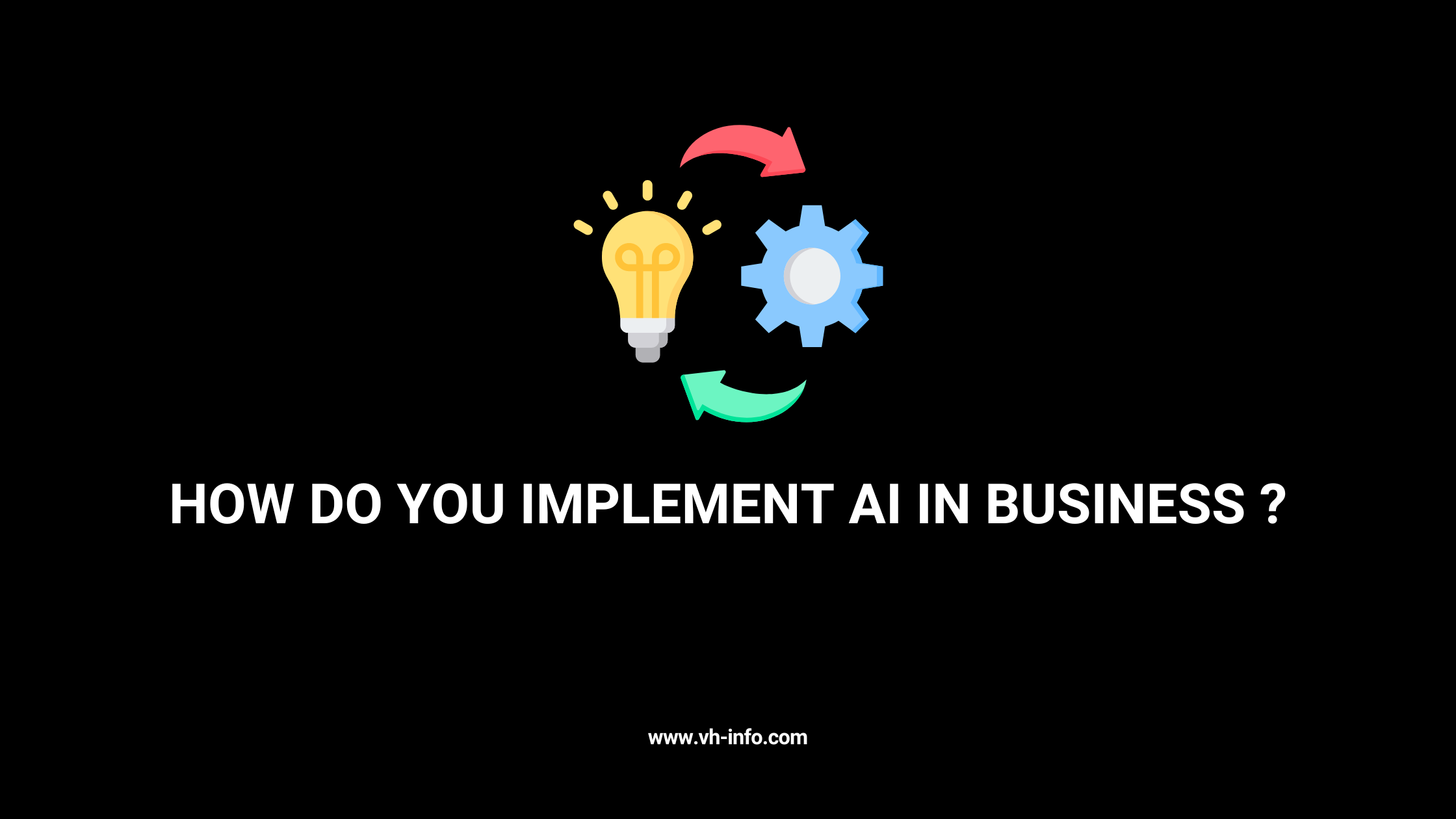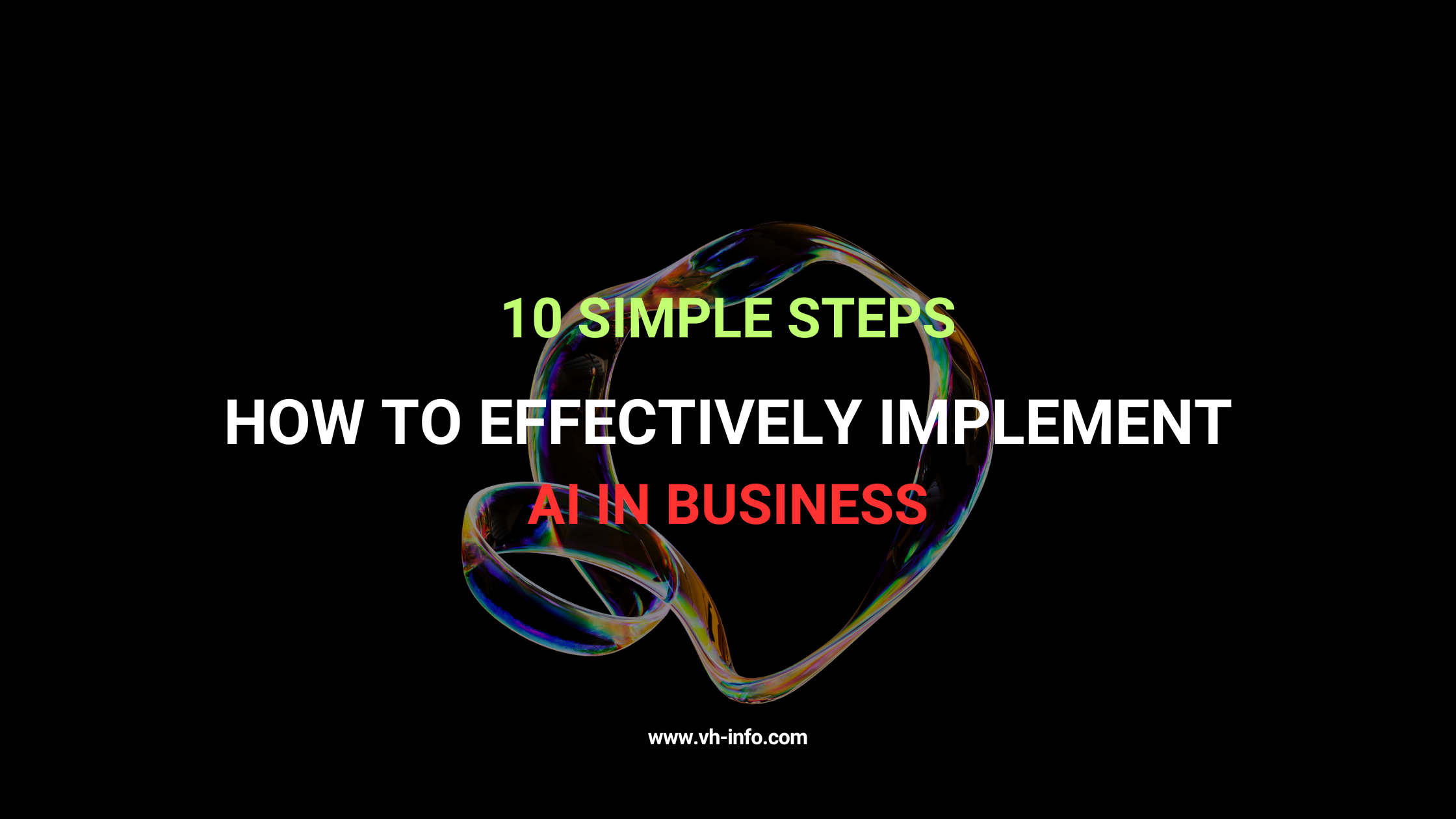Driven by artificial intelligence (AI), the business landscape is changing. From automating tasks to gaining insights from large datasets, AI is poised to revolutionize every aspect of how employees work.
- AI could contribute about $12 trillion to the global economy by 2030, estimates a McKinsey Global Institute report.
- Accenture’s research shows that 84% of executives believe AI will dramatically change the way their businesses compete.
While the potential is there, effectively harnessing AI can be a difficult endeavor. This guide will provide you with the knowledge and steps to successfully integrate AI into your business. We’ll go deeper into defining your goals, assessing readiness, identifying valuable use cases, and building robust data infrastructure. By following this roadmap, you can unlock the true potential of AI and propel your business into a future of efficiency, innovation, and growth.
Benefits of AI in business?

Increased Efficiency and Productivity: AI productivity tools can automate routine tasks, freeing employees to focus on more strategic tasks. For example, AI can be used to automate data entry, schedule appointments, take notes and generate reports.
Improved Decision Making: AI can analyze vast amounts of data and identify patterns and trends that humans might miss. This can help companies make better decisions on everything from marketing and sales to manufacturing and operations.
Enhanced Customer Experience: AI can be used to customize the customer experience, for example by providing chatbots for customer service or product recommendations based on a customer’s previous purchases.
Reduced Costs: AI can help businesses save money by automating tasks and improving efficiency. In addition, AI can be used to detect fraud and prevent theft.
New Products and Services: AI enables companies to create new products and services that were previously impossible. For example, AI is being used to develop self-driving cars and personal assistants. While self-driving cars represent a significant technological advancement, human oversight remains essential. Drivers must still attend driving lessons to understand how to operate and supervise these vehicles safely. This ensures that even with advanced AI, the knowledge and skills of human drivers are indispensable for navigating real-world scenarios and maintaining safety.
Innovation and Creativity: AI can help brainstorm new ideas and solutions. AI is able to analyze vast amounts of data to identify unexpected combinations and patterns, leading to impressive breakthroughs.
Risk Management: AI can be used to assess and mitigate risks by analyzing complex data and identifying potential problems before they occur.
Scalability and Agility: AI systems can process increasing amounts of data and adapt to changing circumstances, enabling companies to scale their operations effectively.
24/7 Operations: AI-powered systems can run continuously, enabling businesses to provide services and support with ease.
Personalized Learning and Training: AI can automate employee training programs based on individual needs and learning styles, improving knowledge retention and skill development.
How do you Implement Ai in business ?

Define Your Goals and Needs:
First matters first, identify what you want AI to achieve in your enterprise. Is it streamlining customer support, improving advertising and marketing campaigns, or optimizing logistics? Having clear goals helps pick the proper AI for the activity.
- Identify areas for improvement: Where can your business be more efficient, productive, or insightful?
- Specify desired outcomes: What do you want AI to achieve? (e.g. reduce costs, personalize marketing, improve customer service)
- Focus on specific tasks: Don’t try to automate everything at once. Pick a well-defined starting point.
- Align with business strategy: Ensure your AI goals contribute to your overall business objectives.
Assess Readiness and Resources:
AI isn’t always magic. Evaluate your enterprise’s preparedness for AI. This consists of elements like information infrastructure, skills with AI knowledge, and price range allocation.
- Data Infrastructure: Does your business have the storage capacity and processing power to handle the data AI systems require?
- Talent: Do you have employees with the skills to manage, maintain, and interpret AI models? Or will you need to hire or train personnel?
- Budget: AI implementation can be costly. Consider the cost of acquiring AI tools, data storage, potential personnel needs, and ongoing maintenance.
- Culture: Is your organization open to adopting new technologies and adapting workflows? A culture of innovation is key for successful AI integration.
Educate Yourself and Your Team:
AI is a powerful device, but it is no longer foolproof. Educate yourself and your crew on AI’s talents and limitations. This fosters trust and guarantees every person is at the equal web page.
- Identify Knowledge Gaps: Pinpoint areas where you and your team need to learn more about AI. This could be understanding core AI concepts, the specific AI application you’re considering, or the ethical implications of AI.
- Explore Learning Resources: There are numerous resources available for AI education, including online courses, workshops, conferences, and books. Choose resources that fit your learning style and the specific knowledge you need.
- Involve Everyone: Don’t limit AI education to technical teams. Educate everyone on the basics of AI and its potential impact on their roles and the business as a whole. This fosters broader understanding and buy-in.
- Encourage Continuous Learning: AI is a rapidly evolving field. Make sure you and your team stay updated on the latest developments by attending industry events, subscribing to AI publications, or setting aside time for self-directed learning.
Identify AI Use Cases:
Not every issue of your business desires AI. Pinpoint particular obligations or workflows wherein AI can upload great cost. For example, AI can automate repetitive responsibilities in HR or examine customer facts for focused advertising and marketing.
- Focus on Pain Points: Identify areas in your business that are inefficient, time-consuming, or prone to errors. These are prime candidates for AI intervention.
- Consider Repetitive Tasks: Look for repetitive tasks that can be automated by AI, freeing up employees for higher-value activities. Many software programs are available for this, such as Ollie, which automates brewery tasks, and Schneider Electric USA, which automates industrial tasks.
- Data-Driven Decisions: If you have a wealth of data but struggle to translate it into actionable insights, AI can analyze it and identify trends or patterns to inform better decision-making.
- Customer Experience Enhancement: Explore how AI can personalize customer interactions, improve lead generation, or provide 24/7 customer support.
- Predictive Maintenance: In sectors with machinery, AI can analyze sensor data to predict equipment failures and prevent downtime.
- Idea Generation and Innovation: Consider using AI to assist with brainstorming or analyzing vast datasets to find hidden connections that might lead to new products or services.
Build a Data Strategy:
AI prospers on facts. Ensure you have a plan for collecting, storing, and coping with wonderful statistics that fuels your AI models.
- Identify data needs: Determine the specific data required to train and run your AI models.
- Source your data: Locate high-quality data, both internal (company records) and external (public datasets).
- Ensure data quality: Clean and organize your data to minimize errors and biases.
- Implement data governance: Establish protocols for data access, security, and compliance.
- Develop data infrastructure: Choose a secure and scalable storage solution for your data.
- Plan for data maintenance: Establish processes for ongoing data updates and quality checks.
Choose the Right AI Tools and Technologies:
There’s a significant array of AI gear to be had, from pre-built solutions to custom development. Consider elements like price range, technical understanding, and scalability when selecting the maximum appropriate option.
- Consider your goals and needs: Align AI tools with what you want to achieve (e.g., pre-built chatbots for customer service, custom image recognition for product inspection).
- Evaluate budget and resources: Assess affordability and technical expertise required for different AI options (e.g., pre-built solutions vs. custom development).
- Think about scalability: Choose tools that can grow with your business demands as your AI use cases expand.
- Research compatibility: Ensure the AI tools integrate seamlessly with your existing software and data infrastructure.
- Explore user-friendliness: If you don’t have a data science team, prioritize user-friendly AI tools with clear interfaces and minimal coding requirements.
Develop and Train AI Models:
If you are building a custom AI solution, this degree involves developing and education the model using your facts. This may additionally require professionals like records scientists or device getting to know engineers.
- Data Preparation: Clean, label, and format your data for the AI model. This ensures the model learns from accurate and relevant information.
- Model Selection: Choose a pre-built AI model or develop a custom one based on your needs and technical expertise. Consider factors like problem type, data format, and desired outcomes.
- Model Training: Train the model on your prepared data. This involves feeding the data into the model and iteratively adjusting its internal parameters to improve accuracy.
- Evaluation and Refinement: Assess the model’s performance through testing and validation. Analyze errors and fine-tune the model by adjusting parameters or acquiring more data if needed.
- Iteration: The development and training process is often iterative. You may need to go back and forth between data preparation, model selection, training, and evaluation to achieve optimal performance.
Pilot Test and Evaluate:
Don’t unharness a complete-scale AI implementation properly. Run a pilot check on a smaller scale to assess its effectiveness and become aware of any troubles.
- Pilot Test: Run a small-scale version of your AI implementation.
- Evaluate: Assess the effectiveness of the AI in achieving your goals.
- Identify Issues: Look for problems with the AI’s performance or integration.
- Refine and Improve: Make adjustments based on the pilot test before full deployment.
Deploy and Integrate:
Once you are satisfied with the pilot take a look at, integrate the AI solution into your present workflows. This would possibly contain device adjustments and employee training.
- Launch the AI solution after successful pilot testing.
- Integrate the AI with existing business workflows.
- This may involve system adjustments for smooth operation.
- Train employees on using the AI tool effectively.
Optimize and Improve:
AI is an ongoing procedure. Monitor your AI implementation and make modifications as needed to optimize performance and preserve pace with evolving commercial enterprise needs.
- Track and Monitor Performance: Regularly assess the AI’s performance against your goals. Monitor key metrics to identify digital marketing areas for improvement.
- Refine Data and Training: Continuously improve the AI’s accuracy by feeding it new, high-quality data and retraining models as needed.
- Gather Feedback and Iterate: Actively solicit feedback from users and stakeholders. Use their insights to identify areas for improvement and iterate on the AI solution.
- Stay Updated with AI Advancements: The field of AI is constantly evolving. Stay up-to-date with new developments and explore their potential to further optimize your AI implementation.
Conclusion
AI holds monstrous capability to convert your commercial enterprise, but navigating its implementation can appear complex. By following a structured method, you could harness the energy of AI successfully.
By following those steps and fostering a culture of innovation, you may embark on a successful AI adventure that unlocks a new generation of performance, productivity, and increase to your commercial enterprise.

